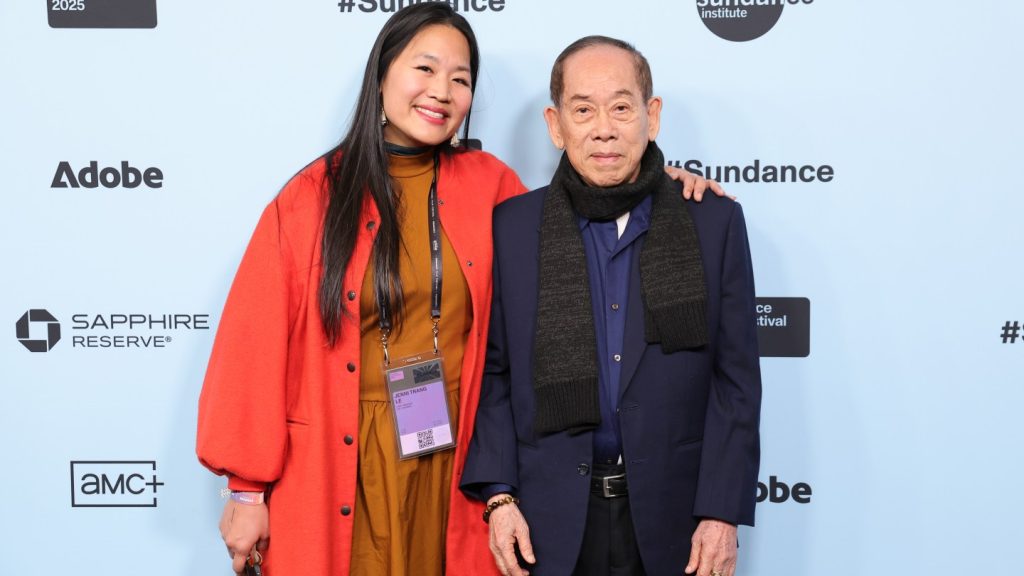A Pulitzer-Winning War Photographer Allegedly Tried to Stop a Sundance Screening of a Doc About Him – Hollywood Reporter

Subscribe for full access to The Hollywood ReporterSubscribe for full access to The Hollywood ReporterThe battle heats up between indie journalists and the Associated Press over a movie questioning the author of an iconic Vietnam image.
By
Steven Zeitchik
Senior Editor, Awards
The retired Associated Press photographer Nick Ut, who is credited with taking the famous “Napalm Girl” photo in 1972, tried to stop Sundance from screening a movie that asserts he isn’t the real photographer, filmmakers told THR on Sunday.
The Pulitzer Prize winner’s lawyers recently sent a cease-and-desist letter to the festival and filmmakers behind the new movie The Stringer, they said; the film world-premiered on Saturday anyway.
A festival representative did not immediately reply to a request for comment. A request for comment for Ut via an AP representative was not replied to by the photojournalist.
Related Stories
Movies
‘Sorry, Baby’ Review: Eva Victor’s Feature Debut Is a Frank, Funny and Tender Spin on the Female ‘Traumedy’
Lifestyle
K-Pop Stars Aespa Partner with Amazon Music for Exclusive Tour Merchandise Collection
The news about the documentary is the latest turn in a quickly escalating battle that has turned Sundance into nothing less than a referendum on the credibility of modern media, with the Associated Press pushing back hard on the film’s claim that Ut didn’t take the photo and the filmmakers firing back in kind, calling the AP’s response to the movie “disgraceful.”
Ut has long been known as the man behind the image emblazoned on the collective brain — the nine-year-old Kim Phuc running from the napalm attack in the nearby town of Trang Bang, her skin burning off from the chemical weapon. The 1972 photo, also known as “The Terror of War,” brought home the horrors of Vietnam to people around the world and also made a celebrity of Ut, who won numerous prizes and spent the past half-century describing how he landed the shot.
No one disputes the authenticity of the image. But in a bombshell revelation in the doc, Carl Robinson — an AP photo editor who worked in the Saigon bureau at the time and left the news organization in 1978 — says that it was in fact a local stringer who had brought in the photo. He was paid $20 and sent on his way.
Yet when it came time to supply credit on the wire, Horst Faas, the late legendary photojournalist for the AP in Saigon, told Robinson to change the attribution to staffer Ut, who was also present at the napalm attack.
Acting on a tip from the whistleblower, documentarian Bao Nguyen (The Greatest Night in Pop) and photojournalist Gary Knight of the France-based press-freedom group VII Foundation set out to find out whether someone else besides Ut took the photo, leading to the documentary.
What seems like a small matter of authorial credit in the film soon becomes a thematic exploration of many of the biggest topics of our time: the closed ranks of a generation of older white men, the exploitation of freelance workers, the unwillingness to see people of color as individuals and, at bottom, who gets to record the world’s history.
“This is a story about the power imbalance in journalism,” Knight said in the interview with THR. “There was an imbalance during the war in Vietnam that tilted toward white heterosexual men and it continues today.”
He added, “The most vulnerable journalists in the world are local freelancers. And it’s important if we’re going to hold political and religious and civic leaders to account that we embrace scrutiny and ask about our own conduct as well.”
Working with the journalists Terri Lichstein and Fiona Turner, Knight set out to raise those questions. The group employed INDEX, a France-based media forensics firm, which ultimately concluded Ut was too far away from Phuc to take the photo. They also interviewed some 55 eyewitnesses and Saigon journalists near Trang Bang that day — some 46 of them ended up on screen — about what they saw during that horrific photo-ready moment.
The filmmakers eventually located a stringer named Nguyen Nghe — a young Vietnam-based photographer who fled to California after the war — who says that it was he who took the photo and who appears on screen to be in great pain about the alleged erasure. The film conjures a simmering level of injustice, made more pungent by the casual dismissal of the allegation by Peter Arnett and other decorated establishment journalists.
“When the truth becomes disregarded, that’s when society becomes corrupted,” Nghe’s brother-in-law says in the film. (What Faas’ motivation for a switch would have been is not clear. Knight says he wonders if credit for the organization’s full-time staff and loyalty to Ut, whose brother was a photojournalist who died in the line of duty, were factors.)
Nghe has been at Sundance, basking in a moment of recognition for a world-changing act he says the world never knew was his.
“That’s why I made the film — to tell Nghe’s story,” Nguyen, who like Ut and Nghe is Vietnamese-American, told THR on Sunday. “Seeing [Nghe’s] reaction at Sundance as he finally gets to bring his story to the world is why I brought this film into the world.”
Or is it not Nghe’s story? The AP continues to maintain that Ut is the author.
The organization said it recently completed a six-month investigation, spurred by the film’s production, concluding in a new report that nothing had changed.
“Our research supports the historical account that Nick Ut took this picture. In the absence of new, convincing evidence to the contrary, AP has no reason to believe this photo was taken by anyone other than Ut,” it said in a statement last week upon its release of the report.
The organization seemed to soften that stance in a statement Sunday after a representative saw the movie at Sundance on Saturday, not emphasizing Ut’s authorship and instead focusing on the lack of access granted by the filmmakers. The AP said it had been unable to review the materials before the screening until it sent someone to watch it in Sundance because the filmmakers had not cooperated.
“For over six months we worked to examine all information about The Terror of War photo, repeatedly asking the filmmakers from the start to share their materials with us so we could properly investigate,” the AP said. “They would not do so unless we signed a non-disclosure agreement or agreed to an embargo, which has hindered our ability to fully investigate and would have prevented us from correcting the record.”
Knight, though, says that the organization was asking to see all the information without preconditions provided by an NDA or embargo — something he couldn’t in good conscience allow because it would mean providing another news outlet with full access to his unreleased journalism.
“If the New York Times was investigating the AP and the AP asked to see all of the New York Times‘ reporting, the Times would have said no, and rightly so,” he told THR. Now that the film is out and no more embargos or NDAs are needed, Knight added, the AP can have access to whatever it wishes. (The AP said in its statement that it “stands ready to review any and all evidence and new information about this photo.”)
Reached by email, an AP representative re-sent the statement. Knight said that the AP had as yet taken no legal action against the filmmakers.
But he said that Ut’s lawyers had sent filmmakers and Sundance executives cease-and-desist letters ahead of the screening seeking to stop it, and applauded the festival for pressing ahead.
Knight says while he believes Ut was at first a victim — the photojournalist, himself 21, didn’t ask for the credit — he has been dining out on someone else’s achievement for decades and built a stellar career on its cracked foundation.
Knight says he also remains troubled by the AP’s approach.
“It is really disgraceful that they shouldn’t embrace scrutiny. For journalists to seek to prevent a film that is an investigation into journalistic practices — I don’t understand that at all,” he said of the nonprofit. (The AP said in its new statement that “We cannot state more clearly that The Associated Press is only interested in the facts and a truthful history of this iconic photo.”)
Prize organizations are also likely to conduct investigations in the wake of the exposé; Ut has also won an Overseas Press Club award, the World Press Photo of the Year and a National Medal of Arts. Nghe notes in the film that, “I worked hard for it, but that guy got to have it all.”
Whatever way the saga ends, The Stringer sheds a light on a news industry that only continues to increase its reliance on freelancers or lower-paid junior reporters. A Pew study in 2022 found that more than a third of the working journalists in America are now freelancers, with the percentage likely considerably higher given how 2023 saw more than 2,600 full-time news jobs cut, and 2024 wasn’t much better. In that regard, Nghe was tragically ahead of the curve according to Nguyen’s movie, showing the way freelancers are both leaned on and brushed aside as needed.
The film also suggests more personal dilemmas, such as over how to grapple with facts that remain uncomfortable or come clean on truths that might be inconvenient. The Hollywood Reporter‘s Sundance review noted that Ut’s willingness to accept credit for work allegedly not his plumbs “novelistic depths…[that’s] the stuff of Conrad or Dostoevsky.”
The film could force the issue, creating a reckoning as the world becomes aware of the authorship questions. And it could throw an uncomfortable light on the power of large news organizations. “Journalism doesn’t belong to big corporations,” Knight said. “It belongs to anyone as a public service.”
But that ending has yet to be printed: in a documentary climate in which corporations are growing increasingly gun-shy, The Stringer does not yet have a distributor.Sign up for THR news straight to your inbox every daySign up for THR news straight to your inbox every daySubscribe for full access to The Hollywood ReporterSend us a tip using our anonymous form.






